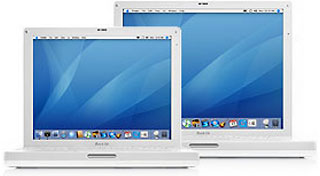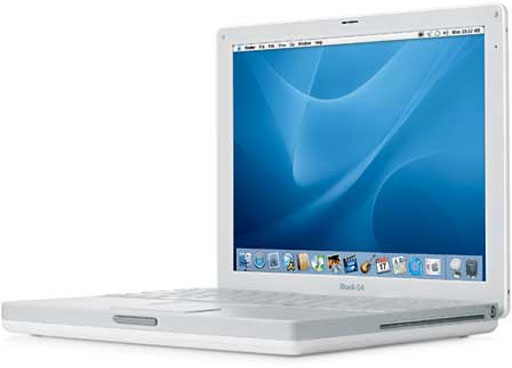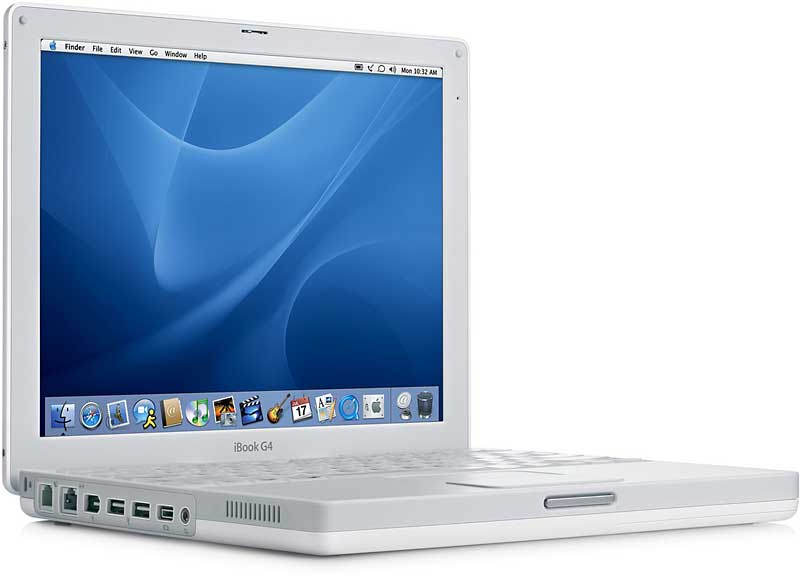
12" and 14" iBook G4
Seven years ago, the final iBooks were released (a 12" 1.33 GHz model and a
14" 1.42 GHz version)
as the last hurrah for the consumer grade PowerPC portables. That 14"
model was a Mac that I know all too well today after purchasing a lot
of five on eBay in January 2010 that
was divided among five family members - including yours truly.
At the time, these units were still selling for $300 to $400 each,
so when many lots of various size showed up at bargain basement prices
(roughly half the typical per-unit cost) from various sources, many
jumped on the opportunity and loaded up.
Lots of New Tech

12" iBook G4
The last generation iBooks added lots of new features that caused
them to hold their value so well for so long:
- Scrolling Trackpad: These are the only iBooks with the 2-finger
scrolling trackpad. This is a great feature for quickly moving to the
top or bottom of a page.
- Bluetooth 2.0+EDR: These iBooks also included built-in Bluetooth
2.0 EDR, which allows for much faster data transfers from
smartphones and other Bluetooth devices compared to the optional
Bluetooth
1.1 offered in the late 2004 models.
- Sudden Motion Sensor: These were the only iBooks to ship with
support for this technology that stops the hard drive heads from
spinning if the iBook takes an unfortunate spill off a coffee table (or
possibly worse), possibly helping preserve your drive and precious data
in such an event
- Core Image:
This is the greatest addition given to these iBooks. Since 2003, well
before the advent of OS X
10.4 Tiger (the first version of Mac OS X to fully support Core
Image), several Macs - including the first Aluminum PowerBooks - began
shipping with capable enough graphics cards to handle Core Image
technology. The last generation iBooks were given the Radeon 9550
graphics chip. While this graphics processor had just 32 MB of VRAM, it
was very capable and somewhat faster than the GeForce 5200FX found in
12" PowerBooks (which had 64 MB of
VRAM). Core Image allows you to really unleash OS X 10.5 Leopard.
- Support for PC2700 DDR RAM and 512 MB of onboard RAM vs. 256 MB for
1.5 GB maximum vs. 1.25 GB for earlier G4 iBooks. This extra memory
also helps with Leopard operation and provides a more realistic amount
to start off with running Tiger.

12" iBook G4
As you can see, all of that new tech gave the 2005 iBook much better
lasting value compared to its previous iterations - but there always
seem to be drawbacks as well.
iBook's Achilles' Heel
Most of the white iBooks can wind up with a bad graphics card
resulting in video artifacts (white spots) and eventual failure
altogether, resulting in the need to replace the logic board. This is
less of an issue on the 2005 iBooks than others, but if you ever need
to swap out the optical drive or hard drive, it's a very difficult
process (nearly a full teardown).

14" iBook G4
Opening up one of these iBooks to service/repair is a very tedious
act - so very much so that if you make one wrong move on a particular
part, you may end up with a ruined logic board that will require an
extremely steady hand and eagle eye to solder and repair. iFixit's
teardown of the iBook G4 14" 1.42 GHz (this
one is particularly for a hard drive replacement) clearly shows how
delicate the cable and socket are that run to the power button from the
logic board:
One false move when performing this illustrated step, and you will
do some irreversible damage (at least for those without a surgeon's
hand with the soldering iron). I happened to have made such a false
move with mine when attempting a hard drive upgrade. I will resurrect
it someday, but for now it's just boxed up waiting a logic board
transplant, since fixing the socket proved to be too cumbersome.
Still Reliable Today
When these iBooks are running trouble-free, they are one of the best
PowerPC portables you can ask for, and I will never forget mine due to
the lot I brokered. Because of the technology added at the end of the
iBook's run, it's no wonder they are still fairly capable today running
Leopard with maxed out RAM.
The iBook came a long way since its 1999 original fruit colored
variants, and at the pinnacle with these 2005 models they may not have
looked as playful as they once did, but they clearly offered much more
in terms of overall performance and technology.
With that said, happy 7th birthday, Mid 2005 iBook - the last of
your kind! 
Dan Bashur lives in central Ohio with his wife and children. He uses various PowerPC G3 and G4 Macs running Tiger and Leopard. Besides finding new uses for Macs and other tech, Dan enjoys writing (fantasy novel series in the works), is an avid gamer, and a member of Sony's Gamer Advisor Panel. You can read more of Dan Bashur's work on ProjectGamers.com, where he contributes regular articles about the PSP, classic gaming, and ways you can use Sony gaming hardware with your Mac.






